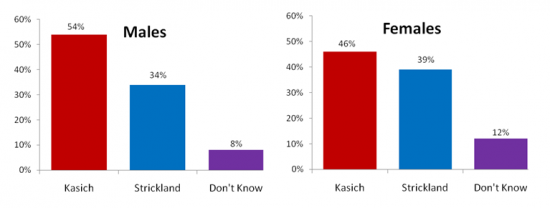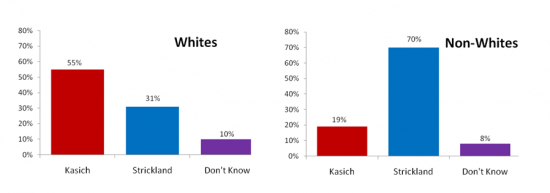Opinion Polling and Elections – Today and Into 2012
It has been an exciting election year in Ohio! Issue 2 garnered national attention, as voters had the chance to repeal Senate Bill 5, which, among other provisions, eliminated collective bargaining rights for all public sector workers. Senate Bill 5 ignited a movement that organized protests at the Statehouse in the spring, collected almost a million petition signatures to get the issue on the ballot, and resulted in the largest voter turnout in an off-year in two decades ultimately overturning the bill by a 61-39 margin. What does this defeat mean for politicians in Ohio, specifically Governor John Kasich who championed the bill, and for potential Republican presidential candidates, and thus President Obama in 2012? A recent public opinion poll conducted among 2011 Ohio voters provides some clues.
The news is not good for Republicans. An opinion poll conducted by the Democratic firm Hart Research Associates offers insight into who voted against Issue 2, as well as how voters perceive Governor Kasich and potential GOP Presidential candidates. As expected, Democrats voted overwhelmingly against Issue 2 (94% voted no), but 57% of independents and 30% of Republicans voted no as well. Responses to additional questions reveal that Kasich’s approval rating among those who voted for him in 2010, but voted against Issue two, is a dismal 28%. In the GOP Presidential arena, 49% said they would be less likely to support Mitt Romney, and 51% said they would be less likely to support Rick Perry after hearing that both Romney and Perry strongly supported Issue 2, (these percentages rise to 73% and 78%, respectively, among only those who voted against Issue 2).
However, all is not lost for the GOP. A somewhat less publicized outcome of this election was the passage of Issue 3, an amendment to the Ohio constitution championed by conservatives. The amendment is intended to exempt Ohioans from any “individual mandates” to purchase healthcare, part of the Affordable Care Act (ACA) passed by the Democratic Congress and considered a significant achievement of President Obama’s administration. The language of the amendment has been criticized by progressives as being dangerously vague, and the vote is viewed by many as symbolic because the legality of the ACA will be decided by federal courts, very likely the Supreme Court. Nonetheless, Issue 3 passed by a whopping margin: 66 to 34.
As it stand in Ohio today, a majority of voters favored one cause championed by Democrats, and another championed by Republicans. Surely, public opinion polls in the coming months will attempt to uncover what issues are most important to voters and how these attitudes and emotions relate to their voting intentions. When conducted properly, opinion polls can predict voters’ actions quite accurately, as well as determine what messages are most persuasive, and thus are a valuable tool for political candidates and organizations. Today both parties appear to have opportunities, and it will be up to them to harness the key issues in ways that will successfully win over voters. And at least in Presidential elections… “as Ohio goes, so goes the nation.”
The Race for Governor: Closer than previously reported?
A recent Cincinnati Enquirer/Ohio Newspaper Poll reveals Republican John Kasich is ahead of Democrat Ted Strickland by 4 percentage points in the race for Ohio’s governor. Why the dramatic difference between this poll and the Columbus Dispatch poll published September 5th, which found Kasich ahead by 12 points? No extraordinary news event has occurred since then to potentially harm Republicans or help Democrats.
As discussed in our previous post, nonresponse bias, a particular problem in mail surveys, likely played a role in inflating Kasich’s lead in the Dispatch poll. The new poll was conducted over the phone – utilizing both landline and cell phone numbers – with a representative sample of 852 likely voters. I’d be more confident in the numbers produced by the latter methodology than a mail survey.
Plenty of time remains between now and November 2nd for Kasich to widen his lead or Strickland to build a comeback. But for now, it seems both candidates still have a chance to win the race.
Political Polls and the Implications of Nonresponse Bias
Election season is upon us and the polls abound. The Columbus Dispatch recently conducted a poll of registered Ohio voters that found Democratic incumbent governor Ted Strickland trailing Republican John Kasich by a whopping 12 points (49% Kasich, 37% Strickland, 10% undecided). In an election season infused with anti-incumbent fervor, Kasich’s lead may not be surprising. On the other hand, this particular 12-point gap seemed a bit odd, and led us to further examine how the poll was conducted.
The Dispatch conducted a mail survey, and calculated poll numbers from the 1,622 registered Ohio voters who completed and returned their ballots. The response rate was 14%, not unusually low for mail surveys. Nevertheless, one might wonder about possible nonresponse bias: did the opinions of the 86% of registered voters who received the ballot but did not return it differ from those who did return ballots? And if so, how might this affect the overall results?
As an example, in the 2006 midterm elections, 49% of actual voters were male and 79% were white. In the Dispatch poll, these groups were overrepresented: 52% of respondents were male and 87% were white. Do these discrepancies matter when drawing conclusions about likely election results? Only if the opinions of male voters differ from female voters, or, if the opinions of white voters differ from the views of non-white voters.
As it turns out, male and white voters are generally more likely to vote Republican than their female and non-white counterparts, as the Dispatch poll itself reveals (see below):
So, would the conclusions drawn from this poll change if more female and non-white voters had returned their ballots? It is likely John Kasich would still be ahead of Strickland, but his lead might not seem so formidable.


